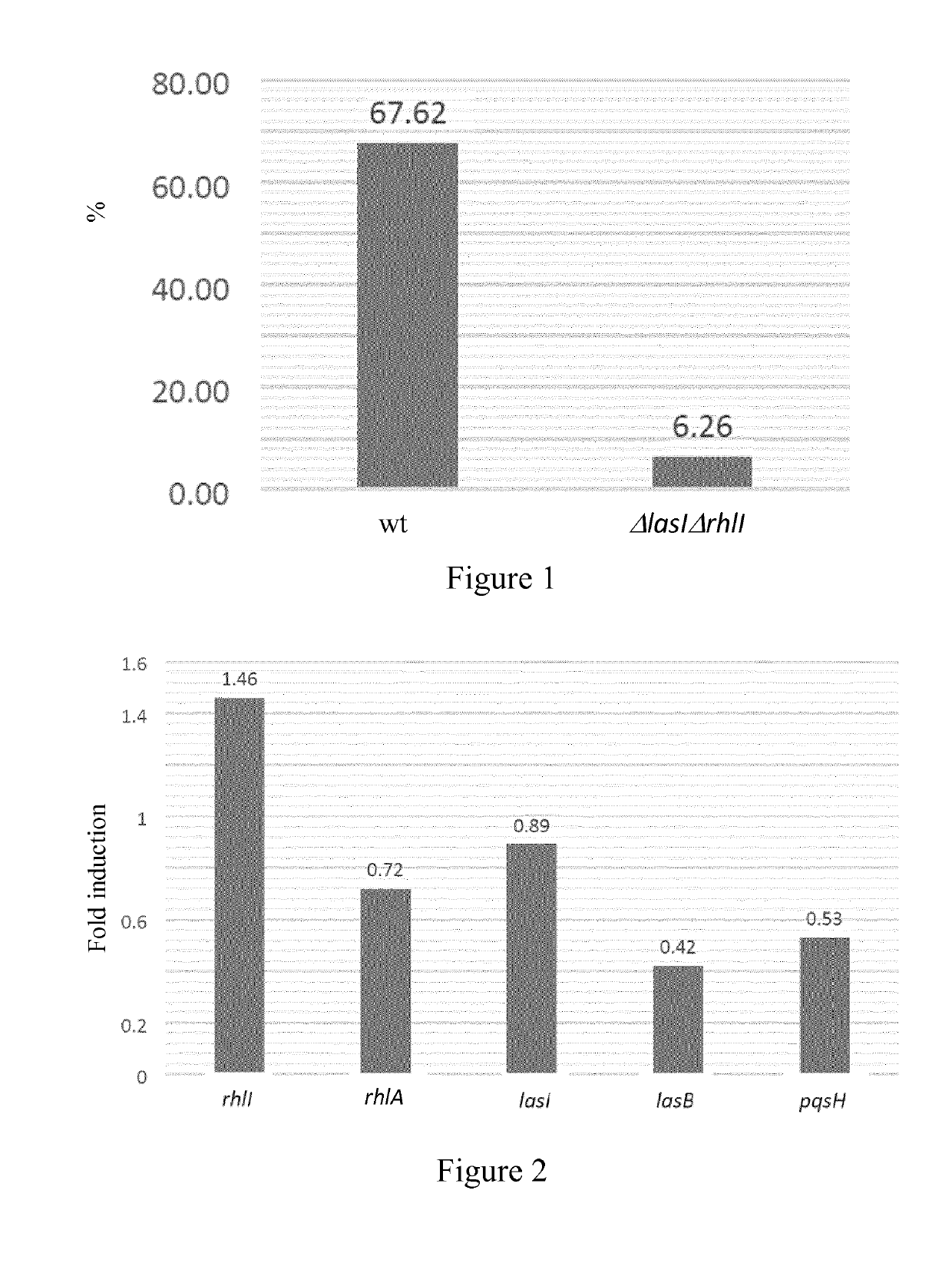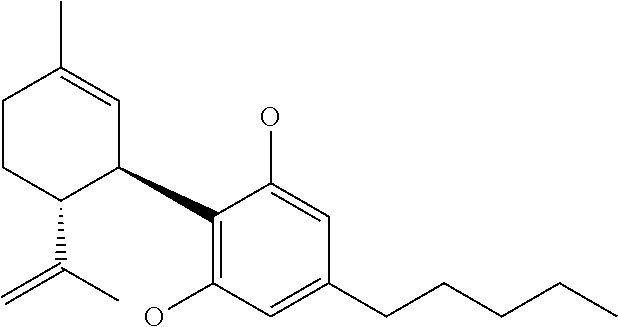Cannabidiol compositions and uses thereof
a cannabinoid and composition technology, applied in the field of antibacterial agents, can solve the problems of increasing morbidity and mortality, affecting the length of patients' stay and related healthcare costs, and exposing patients to adverse effects of antibiotic drug regimens, so as to prevent or reduce the extent of the virulence of this bacteria, effective agents for prevention and/or treatment
- Summary
- Abstract
- Description
- Claims
- Application Information
AI Technical Summary
Benefits of technology
Problems solved by technology
Method used
Image
Examples
example 1
of Biofilm Formation of Pseudomonas aeruginosa by CBD
[0131]The effects of CBD on P. aeruginosa biofilm formation was assessed as described below. Overnight pre-cultures of Pseudomonas aeruginosa ATCC 27853 strain were diluted to an OD600 (optical density measured at a wavelength of 600 nm) of 0.1 in 2 ml of LB (lysogeny broth) medium into polypropylene tubes. Tubes containing bacteria and CBD at concentrations of 1.9 μg / ml, 3.9 μg / ml, 7.8 μg / ml, 15.63 μg / ml, 31.25 μg / ml, 62.5 μg / ml and 125 μg / ml were incubated for 12 h at 37° C. without shaking. Planktonic cells were removed by washing once with distilled water and biofilms were stained with crystal violet (CV, 1% in water) for 30 minutes. CV was discarded and tubes were rinsed twice with water to remove excess of dye. The stained biofilms were re-suspended in 33% acetic acid and their density was evaluated by measuring the OD600 of the suspensions normalized for bacterial density. Measurement of biofilm formation of Pseudomonas aer...
example 2
ed Reduction of Virulence Factors Production by Pseudomonas aeruginosa
[0133]The effect of CBD on the production of elastase by P. aeruginosa, a virulence factor whose expression is directly regulated by the quorum sensing system, was assessed through the measurement of the elastase enzymatic activity.
[0134]Elastase production was measured in two bacterial strains: Pseudomonas aeruginosa PAOW1(PT5) that is a wild type (wt) and Pseudomonas aeruginosa ΔlasIΔrhlI that is a mutant for quorum sensing signaling that has reduced production / expression of elastase due to the inhibition of the quorum sensing system. 100 μl of filtered bacterial supernatant of overnight cultures (with or without 500 μg / ml of CBD, where cultures were under shaking that allows better CBD dispersion) were added to 900 μl of Elastin Congo Red (ECR) buffer (100 mM Tris, 1 mM CaCl2, pH 7.5 containing 20 mg of Elastin ECR) and then incubated with shaking at 37° C. for 3 h. Insoluble ECR was removed by centrifugation ...
example 3
ed Modulation of Expression of Genes Involved in Quorum Sensing of Pseudomonas aeruginosa
[0137]The effects of CBD on P. aeruginosa's quorum sensing system were assessed through the expression of genes related to quorum sensing.
[0138]Overnight pre-cultures of Pseudomonas aeruginosa PAOW1(PT5) (wt) were diluted to an OD600 of 0.05 and grown for 6 hours at 37° C. with or without 500 μg / ml of CBD. 0.5 ml of cultures were added to 1 ml of RNA Protect bacteria solution and total RNA was isolated with RNeasy columns (Qiagen). Residual DNA was eliminated by DNase treatment using 20 units of RQ1 RNase-free DNase (promega). After removal of DNase by phenol / chloroform extraction and precipitation, 500 ng of RNA was reverse-transcribed using random hexamer primers and Improm-II reverse transcriptase (promega). 2.5 μl of 10-fold diluted cDNA were quantified by real-time PCR (qPCR) using a Sybr Select Master Mix for CFX (4472942) (Thermofisher). Primers, start in gene (bp) and amplicon size (bp)...
PUM
| Property | Measurement | Unit |
|---|---|---|
| concentration | aaaaa | aaaaa |
| concentration | aaaaa | aaaaa |
| concentration | aaaaa | aaaaa |
Abstract
Description
Claims
Application Information
 Login to View More
Login to View More - R&D
- Intellectual Property
- Life Sciences
- Materials
- Tech Scout
- Unparalleled Data Quality
- Higher Quality Content
- 60% Fewer Hallucinations
Browse by: Latest US Patents, China's latest patents, Technical Efficacy Thesaurus, Application Domain, Technology Topic, Popular Technical Reports.
© 2025 PatSnap. All rights reserved.Legal|Privacy policy|Modern Slavery Act Transparency Statement|Sitemap|About US| Contact US: help@patsnap.com


